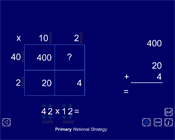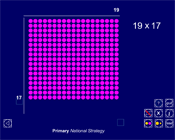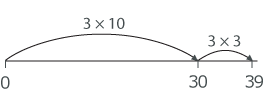Consolidation and practice
These resources are to support children in guided or independent work. Roll over the highlighted resources for a description.
Multiplication grid

This interactive teaching program (ITP) is an ICT-based tool to support the exploration of multiplication. Multiplication grid ITP allows the child or teacher to demonstrate the grid method of multiplication for whole and decimal numbers. The ITP can be used to develop children's abilities to apply their knowledge of number facts and to deduce and reason, when finding missing component numbers.
Multiplication array

This interactive teaching program (ITP) is an ICT-based tool to support the exploration of multiplication. Multiplication array ITP allows the child or teacher to uncover a section of an array of counters, dropping on grid lines to explore methods of multiplication.
Opportunities to use and apply
Confirming learning
Use probing questions and prompts such as:
- Meg drew this number line. What calculation did she work out?

- Show me how you would work out 15 × 4.
- How could partitioning help you to calculate 27 × 6?
- Give me an example of a two-digit by one-digit multiplication you could do mentally. Give me an example of a multiplication where it would help you to jot something down.
 Calculating
Calculating



